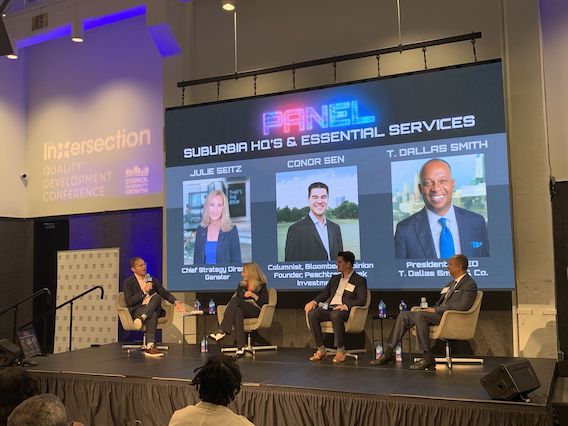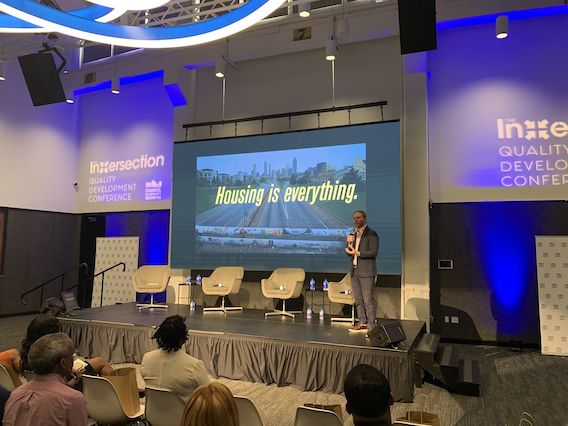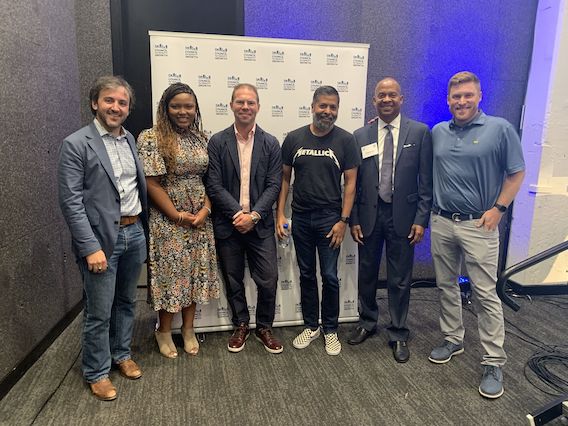














September 15, 2021 | permalink

(Henley & Partners asked me to write a short essay accompanying the launch of their Best Residence-by-Investment Cities for Business Index, a ranking aimed at global nomads and the firms chasing them. Republished below.)
The ‘death of cities’ foretold at the onset of the pandemic was a false prophecy, of course, and not for the first time — but hopefully the last.
For decades, the end of urbanity has been where futurists’ predictions go to die. As far back as 1967, for example, Marshall McLuhan unflinchingly declared that after the advent of his electronic global village, “the circuited city of the future will not be the huge hunk of concentrated real estate”, but “an information megalopolis”. A decade later, Future Shock author Alvin Toffler envisioned working from an “electronic cottage” rather than the office.
Give each man his due — software is eating the world and remote work is here to stay — but the great scattering to a connected countryside hasn’t come to pass, not even after a year-and-a-half of lockdowns or worse. If anything, the opposite happened. The largest US cities all gained population over the last decade, according to newly published census figures collected during the pandemic. Elsewhere, European capitals sprang back to life this spring, while many of Asia’s megalopolises avoided quarantine altogether until the Delta variant came along. How did we ever believe cities might ‘die’?
Urban–rural tension is partly to blame for the ‘dying cities’ myth
The answer is at least as old as the Hanseatic League. The gap between cities and their hinterlands — to say nothing of central governments — has been a fraught one in the West since the decline of medieval city-states and the rise of modern nations. Their tensions and resentments periodically erupt in one asserting its cultural dominance over the other. Or as the sociologist Richard Florida told me bluntly last winter, “Americans don’t like cities, and every time there’s a crisis they start screaming about the death of them.” (See also: Brexit.)
This gap can become a chasm into which every migrant — no matter how high or low their net worth — risks falling. Because international migration is overwhelmingly urban. As I have written previously, the pandemic-era population declines seen in global capitals was less a consequence of residents fleeing than the disappearance of new migrants to replace them.
Open migration policy, happy city
The health and wealth of cities, then, is inextricably bound to the migration and security policies of their federal governments — as New York, London, and Hong Kong have all recently discovered to their lasting regret. It’s no coincidence, for example, that London Mayor Sadiq Khan greeted Brexit with an unrealized proposal for the city’s own immigration scheme, although UK chancellor Rishi Sunak has been more obliging in winning a global tax exemption for the city’s biggest banks.
The new Best Residence-by-Investment Cities for Business Index highlights the risks of cities falling out of sync with their hosts. But it also underscores the opportunities of more tightly aligning urban-and-national migration programs to win the post-pandemic competition for talent in a world upended by remote and stark failures of governance all around. Along these lines, several cities (and city clusters) stand out:
London and New York. Shocking to anyone who seriously entertained the ‘death of cities’ and utterly unsurprising to anyone else, the world’s twin financial capitals top the list. Scoring high across the board in quality-of-life factors — including runaway scores in education (along with Los Angeles) — the duo’s performance underscores their centrality in global flows of talent and migration. They aren’t about to be disrupted by sunny tax havens any time soon. (New York City’s population in particular has surged to an all-time high of 8.8 million, surprising demographers who had estimated tens of thousands of departures.)
Sydney, Singapore, and Auckland. In pre-Covid times, this trio of Asia-Pacific capitals would score highly on nearly any cities index due to their various combinations of security, stability, and competent governance. But those qualities have become perverse liabilities more than a year into the pandemic, as early successes with ‘zero Covid’ policies have crumbled under the mental strain of repeated lockdowns and the highly infectious Delta variant. They’ve proven they can close themselves off from the world, but can they reopen? Singapore and New Zealand are taking tentative steps in that direction, but Sydney appears to have disappeared off the global radar until 2022.
Dubai. After losing nearly a tenth of its population early in the pandemic due to guest worker repatriation, Dubai corrected course through close coordination with Abu Dhabi and its fellow emirates. The city emerged from lockdown late last year as a freewheeling refuge for Europeans fleeing lockdowns, and a national joint venture with Sinopharm to manufacture vaccines locally has helped propel the UAE to the world’s highest vaccination rates. On top of that, Dubai liberalized citizenship and introduced a remote work visa earlier this year, finally taking steps to untether foreign residents from their employers. The triumph of the ‘Dubai model’ can be seen in its impact on projects such as Saudi Arabia’s NEOM — a city being built from scratch with its own courts and immigration system.
Hong Kong. A year after instituting the sweeping national security law that all but heralded the end of “one country, two systems”, the pandemic may be all that’s holding back an exodus. In January, the UK began offering a clear pathway to citizenship for more than 3 million eligible residents, and as of March, more than 34,000 had applied. London is already angling to attract an outsized share of wealthy residents to cement its post-Brexit status, while Vancouver and Toronto are also poised to win more than their fair share of emigrants. Hong Kong isn’t the only city on the list endangered by nationalism — Barcelona also faces difficulties navigating Catalonia’s aspiring independence.
In each case, the ‘death’ and life of great global cities increasingly depends on the willingness of their governments to (re)open borders, promise stability, and welcome migrants. In a world gradually pivoting from the pandemic to what the Intergovernmental Panel on Climate Change predicts will be several decades of mounting climate disasters, safe harbors will be at premium. Let’s hope this marks the end of ‘the end of cities’. We will need them more than ever.
September 11, 2021 | permalink

After being grounded for 18 months, my travel schedule resumes in earnest with the opening keynote at Tirana Design Week on October 2nd, where they’re asking the big questions:
Will the next crisis find us as unprepared as in COVID-19, repeating the same findings over and over again? Or, will we search for how to reinvent our commons city space, streets, public space, parks and green areas, urban furniture, landscapes, leisure areas, commercial zones, and residences? Will socio-ecological interactions within the city change and what does this mean for human behaviour versus urban space or city’s carrying capacity? Are physical and social distancing there to remain, and if so, how are we to prevent collective “agoraphobia” or any form of “social phobia” from taking place in the future? The future is so uncertain right now, but there is no doubt that health and wellbeing will not only persist, but will also grow in importance in city-making.
Conference aside, I’m excited to visit Tirana just to see the transformation of the public realm under Mayor Erion Veliaj, who I invited to speak at reSITE in 2018. (Don’t take my word for it; ask The Economist.) From Tirana, it’s on to Venice to finally see my station at the Architecture Biennale, and then onto Turin for Utopian Hours. I hope to see you somewhere along the way!

September 09, 2021 | permalink
The 21st century could well be the time when the very concept of a city is re-examined and reworked. Profound changes in climate are already forcing us to think about new cities that could replace, for example, low-lying coastal megacities like Lagos, Jakarta and, tomorrow perhaps, Miami. Other cities may be rendered completely unliveable because of heat or lack of water. Never have we needed human ingenuity and innovation more than now.
The 2021 Greenfield Cities Alliance Dialogues will tackle these trends, identify pressing challenges, and showcase innovative solutions. The first webinar on August 25th (watch above) set the stage for the series, examining how master-planning new cities is changing in the wake of these interconnected trends.
The second, invitation-only event will be held in person on September 23rd in New York City, in conjunction with our partners at the Cornell Tech Urban Tech Hub. Please register here for an invitation.
Panelists:
Sarah Moser, Associate Professor, Department of Geography, McGill University
Anthony Townsend, Urbanist-in-Residence, Cornell Tech
Peter Terium, Managing Director of Energy, Water, and Food, NEOM
Gökçe Günel, author of “Spaceship in the Desert: Energy, Climate Change and Urban Design in Abu Dhabi”
Greg Lindsay, Director of Applied Research, NewCities
August 07, 2021 | permalink

On July 29, Atlanta’s Council for Quality Growth hosted its first annual THE INTERSECTION conference at The Gathering Spot ATL. Needless to say, I was thrilled to be back on stage for the first time since the pandemic. Photos from the event are above and below; a full-length video is here, beginning with my opening keynote, and followed by keynotes by Zonda’s Ali Wolf at 24:30 and Secondmuse’s Chante Harris at 1:39:00. A full-length description follows:
This year’s theme - “Innovate or Die: Technology is Disrupting the Development Industry” - discussed critical issues affecting metro Atlanta and the industry as a whole, technology trends and which ones will last, and how development is being impacted by the change that resulted from the pandemic.
Change is happening at the intersection of technology and development, and The INTERSECTION convened experts from across the industry to share their knowledge on how Atlanta can best adapt moving forward.
The half-day conference featured international speakers, including Greg Lindsay, NewCities’ Director of Applied Research, who delivered the first keynote, setting up and moderating the discussion that followed. Other keynote speakers were Zonda’s Ali Wolf and SecondMuse’s Chante Harris.
Panelists were Julie Seitz (Gensler), Conor Sen (Bloomberg Opinion), T. Dallas Smith (T. Dallas Smith & Company), Lawrence Gellerstedt IV (Southsource Advisors), Nathaniel Horadam (Center for Transportation and the Environment), and Pramod “KP” Reddy (Shadow Ventures)
This real estate and development conference will be held annually, adapting the subject matter to the real time issues affecting our industry.


July 29, 2021 | permalink
The folks at CREtech Climate have launched a podcast! Founder and host Michael Beckerman (the biggest mensch in the business) had me on to talk cities, climate migration, and more. Here’s the official description:
“Greg Lindsay, the Director of Applied Research at NewCities dives into top issues that urban leaders are facing today and how those leaders are addressing them. Lindsey also addresses the state of cities today and how cities across the globe are starting to think more holistically about the impacts of climate change.”
Listen at the embedded player above or download on Apple Podcasts.
July 22, 2021 | permalink
President Biden has proposed a $2 trillion infrastructure plan that he states will upgrade roads, bridges, and water systems, expand digital access and broadband, hasten a shift to clean energy, and create millions of jobs. The EU’s $800 billion Recovery Fund also focuses on addressing climate change and the digital transformation as part of its economic recovery plan.
On July 21, the ACG and the Konrad-Adenauer-Stiftung hosted discussion on infrastructure with Greg Lindsay, Director of Applied Research, NewCities, and Non-Resident Senior Fellow, Atlantic Council’s Foresight, Strategy, and Risks Initiative; Brandie Lockett (2018 ACG Sustainable Urban Development), City Designer, Houston Public Works, City of Houston; and Thomas Puls, Senior Economist for Transportation and Infrastructure, Institut der deutschen Wirtschaft; and moderated by Dr. Steven E. Sokol, President, American Council on Germany.
July 15, 2021 | permalink
The good folks at Atlanta’s Council for Quality Growth have invited me to curate, keynote, and host a new conference on the intersection of technology and post-pandemic trends titled, fittingly enough, The Intersection. The full program is below. If you happen to be in Atlanta on July 29, I hope you’ll join us for an amazing program also featuring Zonda’s Ali Wolf, Secondmuse’s Chante Harris, and many more. Ping me for details.
July 06, 2021 | permalink
The team at reSITE — for which I was the visiting curator of the 2018 and 2019 festivals — asked me to interview MIT Architecture and Planning dean and Venice Architecture Biennale curator Hashim Sarkis for a special Biennale episode of its podcast Design & The City. You can listen to it here or wherever fine podcasts are published. I have the additional honor of being exhibited in this edition of the Biennale thanks to my MIT teammates Rafi Segal, Sarah Williams, and Marisa Moran Jahn — the brains behind Open Collectives.
An excerpt of our conversation is below:
Hashim: The Biennale is not about the pandemic, it is about the causes that led us to the pandemic. It is about climate change. It is about how we live together with other species and the planet. It is about increasing political polarisation, and how we can live together across these political divides. It is about growing economic differences and how these are really eroding the idea of a common good, and how we can re-engage that through architecture. It is about mass migrations, and how we can, whether citizens, nomads, tourists, or refugees, find common spaces to live and share. All of these are factors that led us to the pandemic. But this Biennale is not about the pandemic.
The pandemic will probably go away, hopefully, it will go away very soon and we will forget about the two feet, six feet, eight feet. But if we do not address these major issues, other pandemics or other problems will come back to haunt us. That’s what this Biennale is about.
If we do not address these major issues, other pandemics or other problems will come back to haunt us.
Now, you asked me about the end of cities, and I want to remind you of a very similar moment that took place during the Second World War when cities were being bombed, and people were leaving central cities elsewhere to go to the countryside and all. And there was a very lively debate in, and among, urban planners and urban designers about where we will be after the end of the war. Some were saying well, “we will now continue to inhabit the countryside, we will be spreading around because of new transportation systems”. And others were saying “no, we will come back to the city as a way to rebuild and reassert the urban presence”.
I would say that after the war, both happened at the same time, or at different degrees in different settings. And I feel that we will probably face a similar situation now. I do also want to point out that those who fled the city are the ones who could afford to. And therefore, if anything, the pandemic or this phenomenon led to an even bigger divide between the rich and the poor. The rich house and the poor house have become much more strongly distinguished through this public health crisis.
July 05, 2021 | permalink

(The consultancy Henley & Partners asked me to contribute to the firm’s Global Mobility Report Q3 2021 with an essay on the pandemic-era myth about a flight from cities.)
(UPDATE: CNN was kind enough to quote me in its story on the strengths and weaknesses of global passports.)
Of all the misguided predictions made early in the pandemic, ‘the death of cities’ might be the most pernicious, undercutting the wealth and well-being of both residents and the rest of the planet. The cities that make themselves most hospitable to new arrivals in the wake of the pandemic are poised to be the capitals of the new Roaring Twenties.
The combination of contagion and lockdowns in cramped apartments, the story goes, sent inhabitants scurrying to larger homes in the suburbs, small towns, and countrysides, where remote work policies have enabled them to stay. Anecdotally at least, this thesis was buttressed by stories of billionaires decamping to the Hamptons and Florida, Bay Area programmers bidding up homes around Lake Tahoe, and the Notting Hill set setting up shop in Somerset.
While large cities lost larger-than-average numbers of inhabitants during the initial wave of the pandemic in 2020, the real story has less to do with the residents who left than the immigrants who never arrived to replace them.
In the USA, for instance — where the pandemic happened to overlap with the decennial census — the ability to work remotely and a propensity to move correlate most closely with wealth. New Yorkers leaving the boroughs solved their personal housing crises by bringing it with them, arriving in smaller cities such as Nashville with budgets that were 50% higher than those of locals, triggering a nationwide boom in housing prices and widening inequality — a phenomenon seen in London and other global cities as well.
This exodus should have been expected as it represents an acceleration of, rather than a divergence from, prior trends. According to an analysis by Brookings Institution demographer William H. Frey, several of the largest cities in the USA — including New York and San Jose at the center of Silicon Valley — saw declining populations even before the pandemic, while others grew only sluggishly. In most cases, the people who left headed for the suburbs of Sun Belt cities such as Austin, Phoenix, and San Antonio — the same destinations as before there were lockdowns and ‘Zoomtowns’.
What’s different this time is the absence of international migrants due to former President Trump’s travel bans. Frey estimates the number of new arrivals fell by more than half between Trump’s inauguration and last summer, to reach the lowest level in more than 30 years. This matters because overseas arrivals had more than offset departures to warmer and lower-tax destinations. With that faucet turned off, the typical ebb and flow appeared to become a flood of the outwardly-bound.
While Frey’s analysis is limited solely to an American context, a similar phenomenon appears elsewhere. London’s schools face budget cuts after a sharp decline in enrollments attributed in part to European migrants returning home in the face of Brexit. The number of EU citizens searching for work in Britain has fallen by more than a third since Brexit, according to the job-posting site Indeed. ‘Return migration’ and ‘brain-gain’ are officially on the EU’s radar as travel restrictions ease and countries reopen.
As global cities and nations alike grapple with the ramifications of Covid-19, it’s critical they realize the true nature of the threat — and opportunity — before them. Rather than dwelling on wealthy former residents now working from their second or third homes, they must focus on restoring the flow of immigrants.
June 25, 2021 | permalink
(My friends at Plastarc invited me to join this panel on June 22nd to discuss how the pandemic plus a younger generation of corporate leadership has led to changing expectations of work. The official description is below; click on the video above to watch.)
The last decade has seen a progressive redefinition of roles in the strategy, design, and management of workplaces. In people-centric work environments, the new decision makers are not executives in a distant office building—they are the professionals working with users every day. From the coworking-powered emergence of community management to the development of multiple specializations in building technology and facilities management, a new class of experts are remaking workplace experience.
In this panel, we will explore how this new generation of professionals shapes the work environment, supports real-time responsiveness, and builds community. Incorporating insights gained from the mass shift to telework that occurred over the last year, we will also discuss how these new employees can complement the now-ascendant hybrid office, which combines the best of collocated and distributed work.
The event will be hosted by PLASTARC — whose thought leadership has guided companies through people-centric workplace transformations, including moving to ABW — in collaboration with Hushoffice.
Panelists include:
- Greg Lindsay | Director of Applied Research, New Cities Foundation
- Emily Wadman | Sr. Manager of Workplace Experience & Facilities Operations, Toast
- Nellie Hayat | Head of Workplace Transformation, VergeSense
- Azadeh Omidfar Sawyer | Assistant Professor in Building Technology, Carnegie Mellon University School of Architecture

» Folllow me on Twitter.
» Email me.
» See upcoming events.

Greg Lindsay is a generalist, urbanist, futurist, and speaker. He is a non-resident senior fellow of the Arizona State University Threatcasting Lab, a non-resident senior fellow of MIT’s Future Urban Collectives Lab, and a non-resident senior fellow of the Atlantic Council’s Scowcroft Strategy Initiative. He was the founding chief communications officer of Climate Alpha and remains a senior advisor. Previously, he was an urban tech fellow at Cornell Tech’s Jacobs Institute, where he explored the implications of AI and augmented reality at urban scale.

----- | January 22, 2024
The Future of Generative AI in Architecture, Engineering, and Construction
----- | January 1, 2024
----- | August 3, 2023
CityLab | June 12, 2023
Augmented Reality Is Coming for Cities
CityLab | April 25, 2023
The Line Is Blurring Between Remote Workers and Tourists
CityLab | December 7, 2021
The Dark Side of 15-Minute Grocery Delivery
Fast Company | June 2021
Why the Great Lakes need to be the center of our climate strategy
Fast Company | March 2020
How to design a smart city that’s built on empowerment–not corporate surveillance
URBAN-X | December 2019
CityLab | December 10, 2018
The State of Play: Connected Mobility in San Francisco, Boston, and Detroit
Harvard Business Review | September 24, 2018
Why Companies Are Creating Their Own Coworking Spaces
CityLab | July 2018
The State of Play: Connected Mobility + U.S. Cities
Medium | May 1, 2017
Fast Company | January 19, 2017
The Collaboration Software That’s Rejuvenating The Young Global Leaders Of Davos
The Guardian | January 13, 2017
What If Uber Kills Public Transport Instead of Cars
Backchannel | January 4, 2017
The Office of the Future Is… an Office
New Cities Foundation | October 2016
Now Arriving: A Connected Mobility Roadmap for Public Transport
Inc. | October 2016
Why Every Business Should Start in a Co-Working Space
Popular Mechanics | May 11, 2016
Can the World’s Worst Traffic Problem Be Solved?
The New Republic | January/February 2016

January 31, 2024
Unfrozen: Domo Arigatou, “Mike 2.0”
January 22, 2024
The Future of Generative AI in Architecture, Engineering, and Construction
January 18, 2024
The Promise and Perils of the Augmented City
January 13, 2024